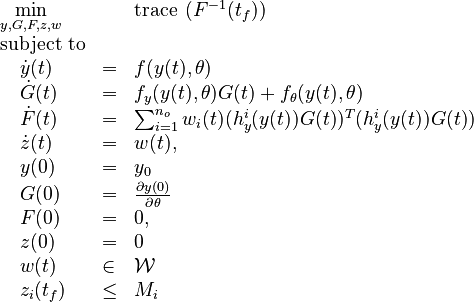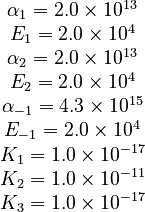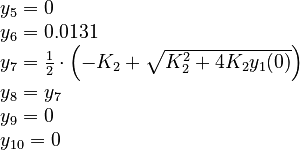DOW Experimental Design
The DOW Experimental Design problem models the OED problem for the parameter estimation problem formulated by the DOW Chemical Co. in 1981. The following formulation is taken from "Nonlinear Parameter Estimation: a Case Study Comparison" by L. T. Biegler and J. J. Damiano add quote.
The chemical species are disguised for proprietary reasons and the desired reaction is given by  , where AB is the desired product. The reactions are described as follows:
, where AB is the desired product. The reactions are described as follows:
Slow Kinetic Reactions:

Acid-Base Reactions:

In order to devise a model to account for these reactions, it is first necessary to distinguish between the overall concentration of a species and the concentration of its neutral form. Overall con- centrations are defined for three components based on neutral and ionic species
![\begin{array}{c}
\left[HBMH\right] = \left[ (MBMH)_N \right] + \left[ MBM^- \right] \\
\left[HA\right] = \left[ (HA)_N \right] + \left[ A^- \right] \\
\left[HABM\right] = \left[ (HABM)_N \right] + \left[ ABM^- \right]
\end{array}](https://mintoc.de/images/math/1/9/8/198f96ccdcb922db2686cd4e04083445.png)
Here ![[ \ ]](https://mintoc.de/images/math/7/5/4/7541b1af090dec7db3eb1953f2b90cc1.png) denotes the concentration of the species in
denotes the concentration of the species in  .
By assuming the rapid acid-base reactions are at equilibrium, the equilibrium constants
.
By assuming the rapid acid-base reactions are at equilibrium, the equilibrium constants  can be defined as
can be defined as
![\begin{array}{c}
K_1 = \frac{[MBM^-][H^+]}{[(MBMH)_N]} \\
K_1 = \frac{[A^-][H^+]}{[(HA)_N]} \\
K_1 = \frac{[ABM^-][H^+]}{[(HABM)_N]}
\end{array}](https://mintoc.de/images/math/8/a/c/8ac2e5336d66902a6171d4af23174ed9.png)
The anionic species may then be represented by
![\begin{array}{cr}
\left[MBM^-\right] = \frac{K_1[MBMH]}{K_1 + [H^+]} & \quad (a) \\
\left[A^-\right] = \frac{K_2[HA]}{K_2 + [H^+]} & \quad (b)\\
\left[ABM^-\right] = \frac{K_3[HABM]}{K_3 + [H^+]}& \quad (c)
\end{array}](https://mintoc.de/images/math/d/4/4/d449ab992818edc956cb507acf683332.png)
Material balance equations for the three reactants in the slow kinetic reactions yield:
![\begin{array}{cr}
\frac{d[M^-]}{dt} = -k_1 \left[ M^- \right] \left[ BM \right] + k_{-1} \left[ MBM^- \right] - k_3 \left[ M^- \right]\left[ AB \right] + k_{-1} \left[ ABM^- \right] & \quad (d)\\
\frac{d[BM]}{dt} = -k_1 \left[ M^- \right] \left[ BM \right] + k_{-1} \left[ MBM^- \right] - k_2 \left[ A^- \right]\left[ BM \right] & \quad (e)\\
\frac{d[AB]}{dt} = -k_3 \left[ M^- \right] \left[ AB \right] + k_{-3} \left[ ABM^- \right] & \quad (f)
\end{array}](https://mintoc.de/images/math/6/a/a/6aaddd7ffa451c9dec8028b5082c4aeb.png)
From stoichiometry, rate expressions can also be written for the total species:
![\begin{array}{cr}
\frac{d[MBMH]}{dt} = k_1 \left[ M^- \right] \left[ BM \right] + k_{-1} \left[ MBM^- \right] & \quad (g)\\
\frac{d[HA]}{dt} = k_2 \left[ A^- \right] \left[ BM \right] & \quad (h)\\
\frac{d[HABM]}{dt} = k_2 \left[ A^- \right] \left[ BM \right] + k_3 \left[ M^- \right] \left[ AB \right] - k_{-3} \left[ ABM^- \right]& \quad (i)
\end{array}](https://mintoc.de/images/math/0/e/2/0e2e5e5f035ffa9f6da8969faafde8ff.png)
An electroneutrality constraint gives the hydrogen ion con-
centration ![\left[ H^+ \right]](https://mintoc.de/images/math/a/d/0/ad0539982a2a429c51ee7e34fc22d0d4.png) as
as
![\left[ H^+ \right] + \left[ Q^+ \right] = \left[ M^- \right] + \left[ MBM^- \right] + \left[ A^- \right] + \left[ ABM^- \right] \quad \quad (j)](https://mintoc.de/images/math/a/c/7/ac79dfa07916df16abf91a7746ab38fb.png)
Based on similarities of reacting species, we assume

With these assumptions, the three rate constants  and
and  must be estimated. Each of these can be fitted with two adjustable model parameters, assuming an Arrhenius temperature dependence. That is
must be estimated. Each of these can be fitted with two adjustable model parameters, assuming an Arrhenius temperature dependence. That is

Here  is the gas constant,
is the gas constant,  is reaction temperature in Kelvins and the parameters
is reaction temperature in Kelvins and the parameters  represent the pre-exponential factor and activation energy, respectively, for the appropriate rate constant.
represent the pre-exponential factor and activation energy, respectively, for the appropriate rate constant.
Mathematical formulation
The chemical processes  can be expressed mathematically as six differential and four algebraic equations:
can be expressed mathematically as six differential and four algebraic equations:
![\begin{array}{lr}
\frac{d y_1}{dt} = -k_2 y_8 y_2 & \quad (1),(h) \\
\frac{d y_2}{dt} = -k_1 y_6 y_2 + k_{-1} y_{10} - k_2 y_8 y_2 & \quad (2),(e) \\
\frac{d y_3}{dt} = -k_2 y_8 y_2 + k_1 y_6 y_4 - \frac{1}{2} k_{-1} y_9 & \quad (3),(i) \\
\frac{d y_4}{dt} = -k_1 y_6 y_4 + \frac{1}{2} k_{-1} y_9 & \quad (4),(f) \\
\frac{d y_5}{dt} = -k_1 y_6 y_2 + k_{-1} y_{10} & \quad (5),(g) \\
\frac{d y_6}{dt} = -k_1 (y_6 y_2 + y_6 y_4) + k_{-1} (y_{10} + \frac{1}{2} y_9) & \quad (6),(d) \\
y_7 = -\left[ Q^+ \right] + y_6 + y_8 + y_9 + y_{10} & \quad (7),(j)\\
y_8 = \frac{\theta_8 y_1}{\theta_8 + y_7} & \quad (8),(b)\\
y_9 = \frac{\theta_9 y_3}{\theta_9 + y_7} & \quad (9),(c)\\
y_{10} = \frac{\theta_7 y_5}{\theta_7 + y_7} & \quad (10),(a)
\end{array}](https://mintoc.de/images/math/8/6/3/86325bf4eba7f12ca92ed49686be22af.png)
Here the letter stands for the corresponding chemical process and the quantity ![\left[Q^+\right]](https://mintoc.de/images/math/2/4/0/2407543fd9ce1429fc92b95baa588317.png) is a concentration which is assumed to be constant during the reactions.
The nine parameters form the vector
is a concentration which is assumed to be constant during the reactions.
The nine parameters form the vector

The predicted concentrations form the vector

Let  denote the right hand side of equation
denote the right hand side of equation  for
for  .
We reformulate the last four algebraic equations as differential ones:
.
We reformulate the last four algebraic equations as differential ones:

The right hand sides of  and
and  are summarized as the vector-valued function
are summarized as the vector-valued function  .
Moreover, let
.
Moreover, let

We are interested in when to measure (with an upper bound  on the measuring time for each observable).
We define
on the measuring time for each observable).
We define

In this approach, we add the so-called sensitivities  . For the differential equations this means
. For the differential equations this means

Now we formulate the OED problem as described in (Optimal Experimental Design for Universal Differential Equations add quote)

Here  is the observed function. The
evolution of the symmetric matrix
is the observed function. The
evolution of the symmetric matrix ![F: \left[0,t_f \right] \rightarrow \mathbb{R}^{9 \times 9}](https://mintoc.de/images/math/7/1/8/718334578e24248dfbe68e385a44ec30.png) is given by the weighted sum of observability Gramians
is given by the weighted sum of observability Gramians
 for each observed function of states. The weights
for each observed function of states. The weights  are the (binary) sampling decisions, where
are the (binary) sampling decisions, where  denotes the decision to perform a measurement at
time
denotes the decision to perform a measurement at
time  .
.
Parameters
The initial parameter estimates are:

The initial model conditions in addition to those given in the data sets are:

Miscellaneous and Further Reading
The Lotka Volterra fishing problem was introduced by Sebastian Sager in a proceedings paper [Sager2006]Address: Heidelberg
Author: S. Sager; H.G. Bock; M. Diehl; G. Reinelt; J.P. Schl\"oder
Booktitle: Recent Advances in Optimization
Editor: A. Seeger
Note: ISBN 978-3-5402-8257-0
Pages: 269--289
Publisher: Springer
Series: Lectures Notes in Economics and Mathematical Systems
Title: Numerical methods for optimal control with binary control functions applied to a Lotka-Volterra type fishing problem
Volume: 563
Year: 2009 and revisited in his PhD thesis [Sager2005]Address: Tönning, Lübeck, Marburg
and revisited in his PhD thesis [Sager2005]Address: Tönning, Lübeck, Marburg
Author: S. Sager
Editor: ISBN 3-89959-416-9
Publisher: Der andere Verlag
Title: Numerical methods for mixed--integer optimal control problems
Url: http://mathopt.de/PUBLICATIONS/Sager2005.pdf
Year: 2005 . These are also the references to look for more details. The experimental design problem has been described in the habilitation thesis of Sager, [Sager2011d]Author: S. Sager
. These are also the references to look for more details. The experimental design problem has been described in the habilitation thesis of Sager, [Sager2011d]Author: S. Sager
How published: University of Heidelberg
Month: August
Note: Habilitation
Title: On the Integration of Optimization Approaches for Mixed-Integer Nonlinear Optimal Control
Url: http://mathopt.de/PUBLICATIONS/Sager2011d.pdf
Year: 2011 .
.
References
| [Sager2005] | S. Sager (2005): Numerical methods for mixed--integer optimal control problems. (%edition%). Der andere Verlag, Tönning, Lübeck, Marburg, %pages% |  |
| [Sager2006] | S. Sager; H.G. Bock; M. Diehl; G. Reinelt; J.P. Schl\"oder (2009): Numerical methods for optimal control with binary control functions applied to a Lotka-Volterra type fishing problem. Springer, Recent Advances in Optimization |  |
| [Sager2011d] | S. Sager: On the Integration of Optimization Approaches for Mixed-Integer Nonlinear Optimal Control, 2011 |  |